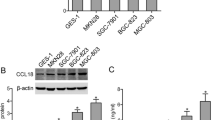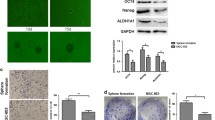Abstract
Background
As a pro-inflammatory cytokine, IL-33 has been demonstrated to play an important role in tumor progression. It is reported that IL-33 is highly expressed in the serum and tumor tissues of patients with gastric cancer. However, the function of IL-33 in gastric cancer remains elusive. We here tried to elucidate the effects of IL-33 on gastric cancer cell invasion and migration.
Methods
Invasion assay and migration assay were performed to assess the effects of IL-33 on gastric cancer cell invasion and migration. ST2 receptor was silenced by siRNA, and ERK1/2 pathway was inhibited by U0126. Protein levels of MMP-3 and IL-6 in cell supernatant were measured by ELISA.
Results
IL-33 promoted the invasion and migration of gastric cancer cells, in a dose-dependent manner. Knockdown of the IL-33 receptor ST2 attenuated the IL-33-mediated invasion and migration. Furthermore, via ST2 receptor, IL-33 induced the activation of ERK1/2 and increased the secretion of MMP-3 and IL-6. In addition, blockage of ERK1/2 pathway resulted in inhibition of invasion and migration induced by IL-33, and downregulation of MMP-3 and IL-6 production.
Conclusions
IL-33 promotes gastric cancer cell invasion and migration by stimulating the secretion of MMP-3 and IL-6 via ST2–ERK1/2 pathway. Thus, IL-33 may be a useful marker for the diagnosis and treatment of gastric cancer.






Similar content being viewed by others
References
Jemal A, Bray F, Center MM, Ferlay J, Ward E, Forman D. Global cancer statistics. CA Cancer J Clin. 2011;61:69–90.
Viudez-Berral A, Miranda-Murua C, Arias-de-la-Vega F, et al. Current management of gastric cancer. Rev Esp Enferm Dig. 2012;104:134–141.
Ikeguchi M, Hatada T, Yamamoto M, et al. Serum interleukin-6 and -10 levels in patients with gastric cancer. Gastric Cancer. 2009;12:95–100.
Onda H, Kasuya H, Takakura K, et al. Identification of genes differentially expressed in canine vasospastic cerebral arteries after subarachnoid hemorrhage. J Cereb Blood Flow Metab. 1999;19:1279–1288.
Schmitz J, Owyang A, Oldham E, et al. IL-33, an interleukin-1-like cytokine that signals via the IL-1 receptor-related protein ST2 and induces T helper type 2-associated cytokines. Immunity. 2005;23:479–490.
Tominaga S, Jenkins NA, Gilbert DJ, Copeland NG, Tetsuka T. Molecular cloning of the murine ST2 gene. Characterization and chromosomal mapping. Biochim Biophys Acta. 1991;1090:1–8.
Bergers G, Reikerstorfer A, Braselmann S, Graninger P, Busslinger M. Alternative promoter usage of the Fos-responsive gene Fit-1 generates mRNA isoforms coding for either secreted or membrane-bound proteins related to the IL-1 receptor. EMBO J. 1994;13:1176–1188.
Liu J, Shen JX, Hu JL, Huang WH, Zhang GJ. Significance of interleukin-33 and its related cytokines in patients with breast cancers. Front Immunol. 2014;5:141.
Hu LA, Fu Y, Zhang DN, Zhang J. Serum IL-33 as a diagnostic and prognostic marker in non-small cell lung cancer. Asian Pac J Cancer Prev. 2013;14:2563–2566.
Musolino C, Allegra A, Profita M, et al. Reduced IL-33 plasma levels in multiple myeloma patients are associated with more advanced stage of disease. Br J Haematol. 2013;160:709–710.
Sun P, Ben Q, Tu S, Dong W, Qi X, Wu Y. Serum interleukin-33 levels in patients with gastric cancer. Dig Dis Sci. 2011;56:3596–3601.
Kunisch E, Chakilam S, Gandesiri M, Kinne RW. IL-33 regulates TNF-alpha dependent effects in synovial fibroblasts. Int J Mol Med. 2012;29:530–540.
Mine Y, Makihira S, Yamaguchi Y, Tanaka H, Nikawa H. Involvement of ERK and p38 MAPK pathways on interleukin-33-induced RANKL expression in osteoblastic cells. Cell Biol Int. 2014;38:655–662.
Chen XJ, Huang YD, Li N, et al. Correlations between serum IL33 and tumor development: a meta-analysis. Asian Pac J Cancer Prev. 2014;15:3503–3505.
Xie Q, Wang SC. IL-33, an important biomarker in non-small-cell lung cancer? Asian Pac J Cancer Prev. 2013;14:7763.
Santulli P, Even M, Chouzenoux S, et al. Profibrotic interleukin-33 is correlated with uterine leiomyoma tumour burden. Hum Reprod. 2013;28:2126–2133.
Zhang P, Liu XK, Chu Z, et al. Detection of interleukin-33 in serum and carcinoma tissue from patients with hepatocellular carcinoma and its clinical implications. J Int Med Res. 2012;40:1654–1661.
Chen SF, Nieh S, Jao SW, et al. The paracrine effect of cancer-associated fibroblast-induced interleukin-33 regulates the invasiveness of head and neck squamous cell carcinoma. J Pathol. 2013;231:180–189.
Bergis D, Kassis V, Ranglack A, et al. High serum levels of the interleukin-33 receptor soluble ST2 as a negative prognostic factor in hepatocellular carcinoma. Transl Oncol. 2013;6:311–318.
Lu DP, Zhou XY, Yao LT, et al. Serum soluble ST2 is associated with ER-positive breast cancer. BMC Cancer. 2014;14:198.
Jovanovic IP, Pejnovic NN, Radosavljevic GD, et al. Interleukin-33/ST2 axis promotes breast cancer growth and metastases by facilitating intratumoral accumulation of immunosuppressive and innate lymphoid cells. Int J Cancer. 2014;134:1669–1682.
Jovanovic IP, Pejnovic NN, Radosavljevic GD, Arsenijevic NN, Lukic ML. IL-33/ST2 axis in innate and acquired immunity to tumors. Oncoimmunology. 2012;1:229–231.
Yagami A, Orihara K, Morita H, et al. IL-33 mediates inflammatory responses in human lung tissue cells. J Immunol.. 2010;185:5743–5750.
Tanabe T, Shimokawaji T, Kanoh S, Rubin BK. IL-33 stimulates CXCL8/IL-8 secretion in goblet cells but not normally differentiated airway cells. Clin Exp Allergy. 2014;44:540–552.
Dhillon AS, Hagan S, Rath O, Kolch W. MAP kinase signalling pathways in cancer. Oncogene. 2007;26:3279–3290.
Luzina IG, Pickering EM, Kopach P, et al. Full-length IL-33 promotes inflammation but not Th2 response in vivo in an ST2-independent fashion. J Immunol. 2012;189:403–410.
Zhao J, Zhang H, Liu SB, et al. Spinal interleukin-33 and its receptor ST2 contribute to bone cancer-induced pain in mice. Neuroscience. 2013;253:172–182.
Conflict of interest
None.
Author information
Authors and Affiliations
Corresponding author
Rights and permissions
About this article
Cite this article
Yu, XX., Hu, Z., Shen, X. et al. IL-33 Promotes Gastric Cancer Cell Invasion and Migration Via ST2–ERK1/2 Pathway. Dig Dis Sci 60, 1265–1272 (2015). https://doi.org/10.1007/s10620-014-3463-1
Received:
Accepted:
Published:
Issue Date:
DOI: https://doi.org/10.1007/s10620-014-3463-1




